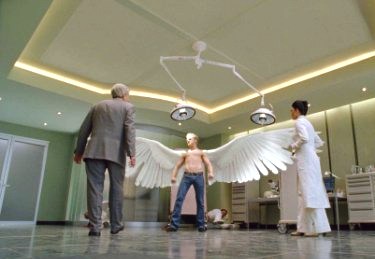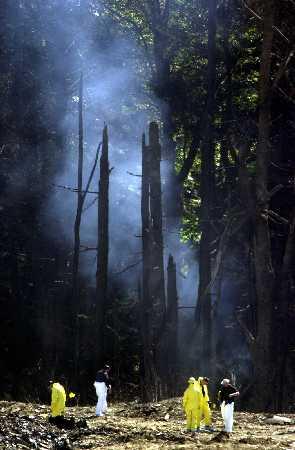 With original director Bryan Singer jumping ship to make Superman Returns, the once-noble X-Men franchise has been handed to second-tier talent Brett Ratner to ruin, and in The Last Stand, ruin it he most emphatically does. You know you’re watching a Ratner when the transfatty acids in the popcorn franchise outing don't sit well when sprinkled with the hundreds and thousands of the After The Sunset director’s failings.
With original director Bryan Singer jumping ship to make Superman Returns, the once-noble X-Men franchise has been handed to second-tier talent Brett Ratner to ruin, and in The Last Stand, ruin it he most emphatically does. You know you’re watching a Ratner when the transfatty acids in the popcorn franchise outing don't sit well when sprinkled with the hundreds and thousands of the After The Sunset director’s failings. Driven by millionaire industrialist Warren Worthington's (Michael Murphy) desire to 'cure' his own son, Warren Junior (Ben Foster), who has grown a fine pair of angel’s wings, a drug that reverses the X-gene mutation, the source of all the superheroes (and supervillains) powers, is developed. With the President opening clinics to allow mass vaccinations, and plenty of mutants wanting to become ‘normal’, a strained political situation spills over into war.
On one side Magneto (Ian McKellen) gathers a ragtag army of discontent cyberpunk mutants who think that destroying all non-mutants to stop the President enforcing a medical threat to their existence. On the other side, the head of the X-Men school Prof. Charles Xavier (Patrick Stewart), with the help of political animal (literally) Dr. Hank McCoy (Kelsey Grammer) search desperately for a diplomatic solution.
Then there’s the one in the middle that causes all the trouble, resurrected super-vixen Jean Grey (Famke Janssen), who returns as a fire-breathing, omnipotent angel of death, to find the third way, the pyrotechnic realpolitik of blockbuster Armageddon. Her policy of turning those who conspire to tick her off into beautifully rendered dust doesn’t deter the mutton-chopped Wolverine (Hugh Jackman), who is desperate to rekindle his love for her. Or kill her. Or maybe it’s rekindle while killing. He looks as confused about it as anybody. Nevertheless, the battle lines have been drawn more or less, and there’s a hefty chunk of special-effects budget to get through, so it all kicks off.
Ironically there’s a returning character, Rogue (Anna Paquin, just about) who cannot touch people or she’ll suck the life out of them. Ratner should have squeezed into her skin-tight costume himself. His carnival style, flashy and nausea-inducing, pushes character and story way into the background while mechanically executing enormous stunt set-ups that quickly become repetitive. When you’ve seen one magnetically-propelled station-wagon doused with flames, turning it into an impromptu weapon, you’d imagine you’d seen them all. Ratner will repeat the trick thirteen times, regardless. You get to wondering if he hadn’t finished working it all out with Dinkies and a Zippo on the carpet of his Winnebago before the knock on the door came to call him to the set.
This flashy longueur comes at just the wrong point, smack bang in the middle of the ultimate battle; the final stand-off between good and evil mutants that loyal fans have waited three long movies for. The franchise is known for its variety of characters, interlocking stories and grand themes, or rather, it was. Here we have a great start and a muddled middle that has only one place to go. When it gets there, an odd thing happens. The X-Men go out in a unique way, with a very loud, percussive whimper rather than the anticipated bang.
The new characters are given a couple of short scenes to do their various party-pieces. Trailer Park Boys fans will spot Ellen Page as Kitty, the teenager who can walk through walls with the same facility as she can steal boyfriends. Later she battles Vinnie Jones (I know, tsk) as Juggernaut, a strong-man, in a race through a long building inspired by an old Levi’s commercial. At least they get a go. Foster as Angel is anonymous, except in long-shot and mid-flight. Magneto’s new recruits, a porcupine guy and a very quick woman among them, get an introduction and a blurry fight scene and goodnight.
Whole sections of The Last Stand eluded me, being either so thinly sketched as to be subliminal, like Olivia William’s turn as a bespectacled Scottish doctor, or so lumpen that you have to crane your neck to see around them; like the deaths of major characters or the whole ‘Learn To Love The Mutant Inside” thing. The big moments arrive on cue, some more effectively used than others. We are treated to Ratner’s take on the motorway convoy pile-up, following the lead set by the Wakowski Brothers and Michael Bay before him, which is well handled without being extraordinary. Later, the fine idea of shifting the Golden Gate Bridge in San Francisco to form an impromptu passage to Alcatraz and the final battle gets mired in shabby, over-used stunt work and ho-hum special effects. More does not always mean better, but at least they’ve promised there won’t be another one.
Or have they? The studio rep at the screening urged us, the seat-flipping critical press, to wait until after the credits for an extra scene. It’ll be worth it, we were told. After staring diligently at a five minute scrawl of special-effects personnel and stunt-people, there is indeed a 'hidden' scene. It is not an apology from Stan Lee.
 As everybody knows, on the morning of the 11th of September, 2001, four American airplanes were hijacked by al-Qaeda operatives, two of which crashed into the World Trade Centre towers in Manhattan, one into the Pentagon in Washington DC and the other into a field outside Pennsylvania. Paul Greengrass’ harrowing United 93 is the story of what happened to the last plane and is one of the films of the year.
As everybody knows, on the morning of the 11th of September, 2001, four American airplanes were hijacked by al-Qaeda operatives, two of which crashed into the World Trade Centre towers in Manhattan, one into the Pentagon in Washington DC and the other into a field outside Pennsylvania. Paul Greengrass’ harrowing United 93 is the story of what happened to the last plane and is one of the films of the year.







